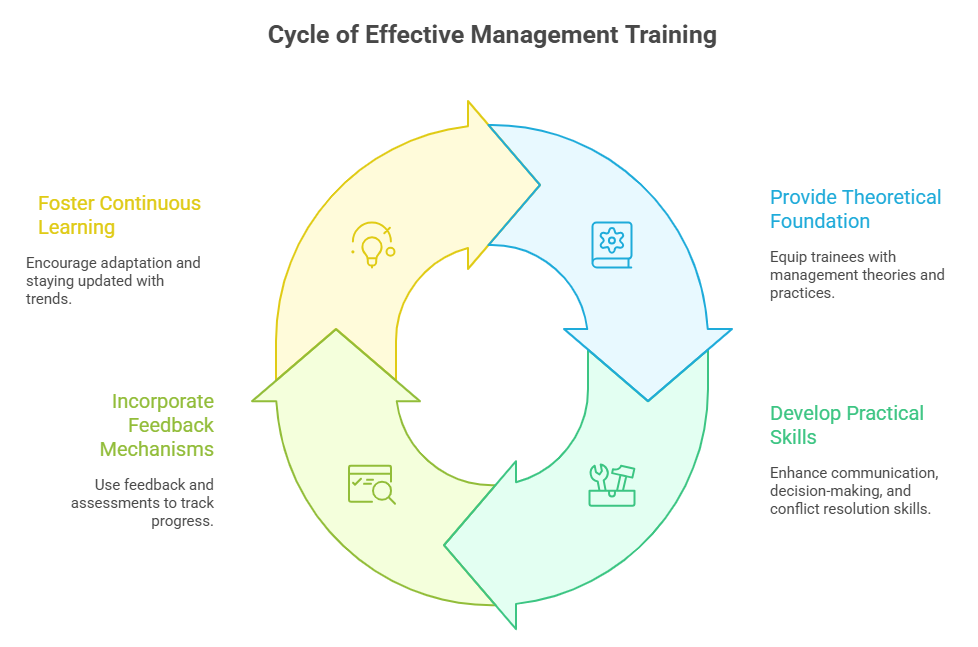Effective management is the backbone of any successful organization. Whether you’re leading a small team or overseeing large-scale operations, the skills you possess as a manager directly impact productivity, employee satisfaction, and overall business outcomes. This blog dives into the importance of management training, addresses common challenges faced by managers, and provides actionable solutions to help you excel in your role.
Why Management Training Matters
Management training equips professionals with essential tools to navigate the complexities of leadership. From handling team conflicts to making informed decisions, the right training program can transform managers into confident leaders who drive organizational success.
Common Challenges Faced by Managers
Managers often encounter hurdles that hinder their ability to lead effectively:
- Lack of leadership skills: Many managers are promoted based on technical expertise but lack formal leadership training.
- Difficulty in decision-making: Without proper guidance, making strategic decisions can become overwhelming.
- Team conflicts: Managing diverse personalities and resolving disputes requires specialized skills.
- Adapting to change: Rapid shifts in business environments demand agility and foresight.
Key Components of Effective Management Training

A well-rounded management training program should address the following areas:
1. Leadership Development
Leadership is more than delegating tasks—it’s about inspiring and guiding your team toward shared goals. Training programs should focus on building confidence, emotional intelligence, and communication skills to foster trust and collaboration within teams.
2. Decision-Making Skills
Managers often face high-pressure situations requiring quick yet thoughtful decisions. Training modules should include frameworks for analyzing scenarios, weighing options, and choosing the best course of action.
3. Conflict Resolution Techniques
Team conflicts can disrupt productivity and morale if not handled effectively. Management training should teach strategies for mediating disputes, promoting open communication, and maintaining harmony within teams.
4. Time Management and Prioritization
Balancing multiple responsibilities can be challenging for managers. Training programs should emphasize techniques for setting priorities, delegating tasks, and managing time efficiently to maximize productivity.
5. Adaptability in Changing Environments
The business landscape is constantly evolving due to technological advancements, market shifts, and global trends. Managers must learn how to adapt quickly while maintaining focus on organizational goals.
You Must Know
HR Executive Job Description: Key Roles, Responsibilities & Must-Have Skills
Campus to Corporate Training: Essential Modules, Benefits & Top Providers in India
Pain Points in Management Training—and How to Solve Them
Despite its importance, management training often falls short due to several pain points:
1. Lack of Real-World Application
Many training programs focus on theory without providing practical tools managers can apply immediately. Solution: Incorporate hands-on exercises, case studies, and simulations into training sessions to bridge the gap between learning and implementation.
2. Irrelevant Content
Generic training content fails to address specific challenges faced by individual managers or industries. Solution: Tailor programs to align with organizational goals and individual roles.
3. The Forgetting Curve
Managers often forget what they’ve learned shortly after completing training sessions. Solution: Offer continuous learning opportunities through refresher courses, microlearning modules, or mentorship programs.
4. Passive Learning Methods
Traditional lectures or videos don’t engage participants effectively. Solution: Use interactive methods such as workshops, role-playing exercises, and group discussions to enhance engagement.
Best Practices for Effective Management Training
To create impactful management training programs that address pain points and deliver results, consider these best practices:
1. Set Clear Goals
Define specific objectives for your training program based on organizational needs and individual manager roles. For example, improving decision-making skills or enhancing team collaboration might be key priorities.
2. Tailor Content to Individual Needs
Avoid a one-size-fits-all approach by customizing content based on skill gaps, industry requirements, and organizational goals. Personalized training ensures relevance and boosts engagement.
3. Incorporate Technology
Use digital platforms for e-learning modules that allow managers to access resources anytime they need them. Online tools also make it easier to track progress and provide feedback.
4. Encourage Active Participation
Interactive sessions such as group projects or real-world problem-solving exercises help participants retain information better than passive learning methods.
5. Measure Impact
Evaluate the effectiveness of your management training program by tracking metrics like employee satisfaction scores, team performance improvements, or retention rates. Use this data to refine future sessions.
Benefits of Investing in Management Training
Organizations that prioritize management training reap numerous rewards:
- Improved Team Performance: Skilled managers can motivate employees and foster collaboration more effectively.
- Higher Employee Satisfaction: Employees feel valued when led by competent leaders who understand their needs.
- Enhanced Productivity: Managers equipped with time management skills ensure tasks are completed efficiently.
- Reduced Turnover Rates: Strong leadership contributes to a positive work culture where employees want to stay long-term.
Conclusion
Management training is not just an investment in individuals—it’s an investment in the future success of your organization. By addressing common challenges through tailored programs that focus on leadership development, decision-making skills, conflict resolution techniques, time management strategies, and adaptability in changing environments, you can empower managers to excel in their roles while driving overall business growth.
If you’re looking for ways to improve your managerial capabilities or implement an effective training program within your organization, start by identifying pain points and adopting solutions that align with your goals. With the right approach, you can transform challenges into opportunities for growth—and achieve lasting success as a leader!
